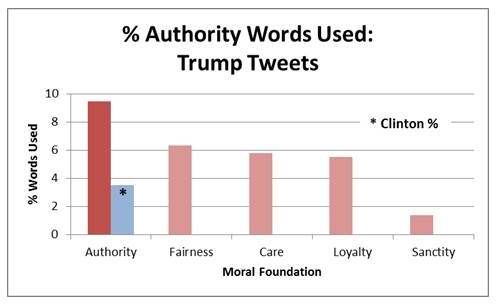President Donald Trump
Is Trump a Tyrant? What His Tweets Say
30 days of Trump tweets provide systematic evidence about Trump and tyranny.
Posted June 12, 2016
Liberal firebrand Senator Elizabeth Warren called him a “wannabe tyrant.” The conservative magazine National Review ran an essay titled, “Donald Trump: Thin-Skinned Tyrant.” This tyrant talk seems to be sticking to “the Donald,” the presumptive Republican presidential nominee for 2016.
That’s a pretty tough label to stick on someone. Some horrifically bad guys have been called “tyrant”:
- Caligula (Roman Emperor, 37-41 AD)
- Ivan IV (Tsar of Russia, 1533-1584)
- Josef Stalin (General Secretary of the Soviet Union, 1922-1953)
- Adolf Hitler (Chancellor of Germany, 1933-1945)
- Mao Tse Tung (Chairman of the Communist Party of China, 1949-1976)
- Nicolae Ceausescu (General Secretary of the Romanian Communist Party, 1965-1989)
- Pol Pot (General Secretary of the Communist Party of Cambodia, 1963-1981)
- Idi Amin (President of Uganda, 1971-1979)
- Bashar al-Assad (President of Syria, 2000-present)
- Kim Jong-Un (Supreme Leader of North Korea, 2011-present)
![//www.gnu.org/copyleft/fdl.html) or CC-BY-SA-3.0 (http://creativecommons.org/licenses/by-sa/3.0/)], Wikimedia Commons; Stalin: неизвестный (unknown) [Public domain], Wikimedia Commons; https://commons.wikimedia.org/wiki/File%3AStalin_Joseph.jpg; Hitler: Bundesarchiv, Bild 183-H1216-0500-002/CC-BY-SA 3.0 [CC BY-SA 3.0 de (http://creativecommons.org/licenses/by-sa/3.0/de/deed.en)], Wikimedia Commons; Mao: Zhang Zhenshi (1914–1992). Mao Zedong portrait attributed to Zhang Zhenshi et al. [CC BY 2.0 (http://creativecommons.org/licenses/by/2.0)], Wikimedia Commons; Ceausescue: Mittelstädt, Rainer [CC BY-SA 3.0 de (http://creativecommons.org/licenses/by-sa/3.0/de/deed.en)], Wikimedia Commons; Amin: Archives New Zealand [CC BY 2.0 (http://creativecommons.org/licenses/by/2.0)], Wikimedia Commons; Al-Assad: Kremlin.ru, CC BY 4.0, https://commons.wikimedia.org/w/index.php?curid=44370013; Kim: P388388, Wikimedia Commons CC BY-SA 4.0, https://commons.wikimedia.org/w/curid=37757238 //www.gnu.org/copyleft/fdl.html) or CC-BY-SA-3.0 (http://creativecommons.org/licenses/by-sa/3.0/)], Wikimedia Commons; Stalin: неизвестный (unknown) [Public domain], Wikimedia Commons; https://commons.wikimedia.org/wiki/File%3AStalin_Joseph.jpg; Hitler: Bundesarchiv, Bild 183-H1216-0500-002/CC-BY-SA 3.0 [CC BY-SA 3.0 de (http://creativecommons.org/licenses/by-sa/3.0/de/deed.en)], Wikimedia Commons; Mao: Zhang Zhenshi (1914–1992). Mao Zedong portrait attributed to Zhang Zhenshi et al. [CC BY 2.0 (http://creativecommons.org/licenses/by/2.0)], Wikimedia Commons; Ceausescue: Mittelstädt, Rainer [CC BY-SA 3.0 de (http://creativecommons.org/licenses/by-sa/3.0/de/deed.en)], Wikimedia Commons; Amin: Archives New Zealand [CC BY 2.0 (http://creativecommons.org/licenses/by/2.0)], Wikimedia Commons; Al-Assad: Kremlin.ru, CC BY 4.0, https://commons.wikimedia.org/w/index.php?curid=44370013; Kim: P388388, Wikimedia Commons CC BY-SA 4.0, https://commons.wikimedia.org/w/curid=37757238](https://cdn2.psychologytoday.com/sites/default/files/styles/image-article_inline_full/public/field_blog_entry_images/Tyrants.jpg?itok=06lkc-z6)
All of these guys held virtually unlimited power in their countries and, for instance, evidence indicates Hitler, Pol Pot, and Stalin killed millions of their countrymen and women, while Caligula ruled with sadism, extravagance, and, most famously, sexual perversion.
MORE MUNDANE TYRANNY
These examples provide extreme cases, and I doubt his critics think these monsters represent the true benchmark for a tyrant. I suspect they think more in line with the great Greek philosopher Aristotle, who defined tyranny as the “arbitrary power of an individual which is responsible to no one, and governs all alike, whether equals or better, with a view to its own advantage, not to that of its subjects, and therefore against their will.” Or with Black’s Law Dictionary, which says a tyrant is “a ruler…who uses his power unjustly and arbitrarily, to the oppression of his subjects.” These are fairly consistent with general dictionary definitions like Merriam-Webster’s, which defines a tyrant as “an absolute ruler unrestrained by law or constitution.”
These seem like more realistic characteristics that can be applied to a 21st Century US politician.
IN HIS OWN TWEETS
With this in mind, I wanted to test systematically how tyrannical the Donald is as indicated by his own words. So I ventured into his Twitterverse at @realDonaldTrump and randomly selected 30 days of his tweets between the day he announced his candidacy last June until the end of May (i.e., June 16, 2015, to May 31, 2016). This resulted in 290 tweets or almost 10 tweets per day.
Then I matched his tweets to a dictionary of words based on the authority/subversion foundation identified in Moral Foundations Theory (MFT). MFT argues there are five universal values that drive our sense of morality. In addition to authority/subversion, they are care/harm, fairness/cheating, loyalty/betrayal, and sanctity/degradation. They are universal, and presumably more comprehensive than conventional definitions informed only by Western values, because they also capture evolutionary and cross-cultural (i.e., non-Western and religious) conceptions of morality.
The originators of MFT describe the authority/subversion foundation as follows:
This foundation was shaped by our long primate history of hierarchical social interactions. It underlies virtues of leadership and followership, including deference to legitimate authority and respect for traditions.
Words that reflect authority include: obey, duty, respect, authority, permission, command, and comply. On the other hand, words that indicate subversion include: defiance, disobey, lawless, protest, disrespect, unfaithful, and obstruct. You can see the full lists of words here.
(Note that this is a very low bar for tyranny but certainly one any leader would have to reach before being considered a tyrant.)
For comparison, the care/harm foundation focuses on if a person prevents or relieves harm to others (also using words like compassion and hurt). The fairness/cheating foundation concentrates on if a person acts fairly and justly toward others and reciprocates appropriately in social and economic exchanges (also referencing words like justice and discriminate). The loyalty/betrayal foundation emphasizes whether a person makes personal sacrifices or not for other members of her or his group (referring to other words like group and foreign). And the sanctity/degradation foundation concerns attempts to live in a more principled, less corporeal way (invoking other words like clean and disgust).
- - - - - For more Moral Foundations Theory at “Caveman Politics” - - - - - - - - -
"Which of the 5 Types of Political Moralizer are You?"
"Which of the 5 Political Moralizers are PT Blog Readers?"
"Could Disgust Make You an Environmentalist?"
"Are You Easily Disgusted? You May Be a Conservative"
- - - - - - - - - - - - - - - - - - - - - - - - - - - - - - - - - - - - - - - - - - - - - - - - - - - - - - - - -
As the bar chart shows, Trump was much more likely to use authority-based words in his tweets—in particular control, honor, illegal, leader, refuse, respected, and status—than any of the other types of MFT-based words. He used words related to authority/subversion 9.5% of the time, which is nearly 50% more than his next most widely used category, fairness/cheating, which he used 6.4% of the time.

In comparison, a similar analysis of tweets by Hillary Clinton, presumably his major opponent for the presidency, shows he used authority-based words almost three times more often than she did. Clinton, on the other hand, was much more likely to use care-based words (stay tuned for my next blog).
TRUMP THE TYRANT?
These very limited but systematic analyses of Trump’s own words suggest he’s more reliant on authority-oriented words than other types of morality-based words or than his major opponent.
Do these results mean he’s a “wannabe” or “thin-skinned” tyrant? To me it means he frequently thinks in terms of social hierarchies and accompanying norms. Tyrant though? Maybe. But given the extraordinarily negative connotations of the word, I’d urge great care in the use of term. I suspect tyranny, like beauty, is in the eye of the beholder.
- - -
In addition to writing the "Caveman Politics" blog for Psychology Today, Gregg is the Executive Director of the Association for Politics and the Life Sciences and an Associate Professor of Political Science at Texas Tech University. You can find more information on Gregg at GreggRMurray.com or follow him on Twitter at @GreggRMurray.
If you enjoyed this post, please share it by email or on Facebook or Twitter.




